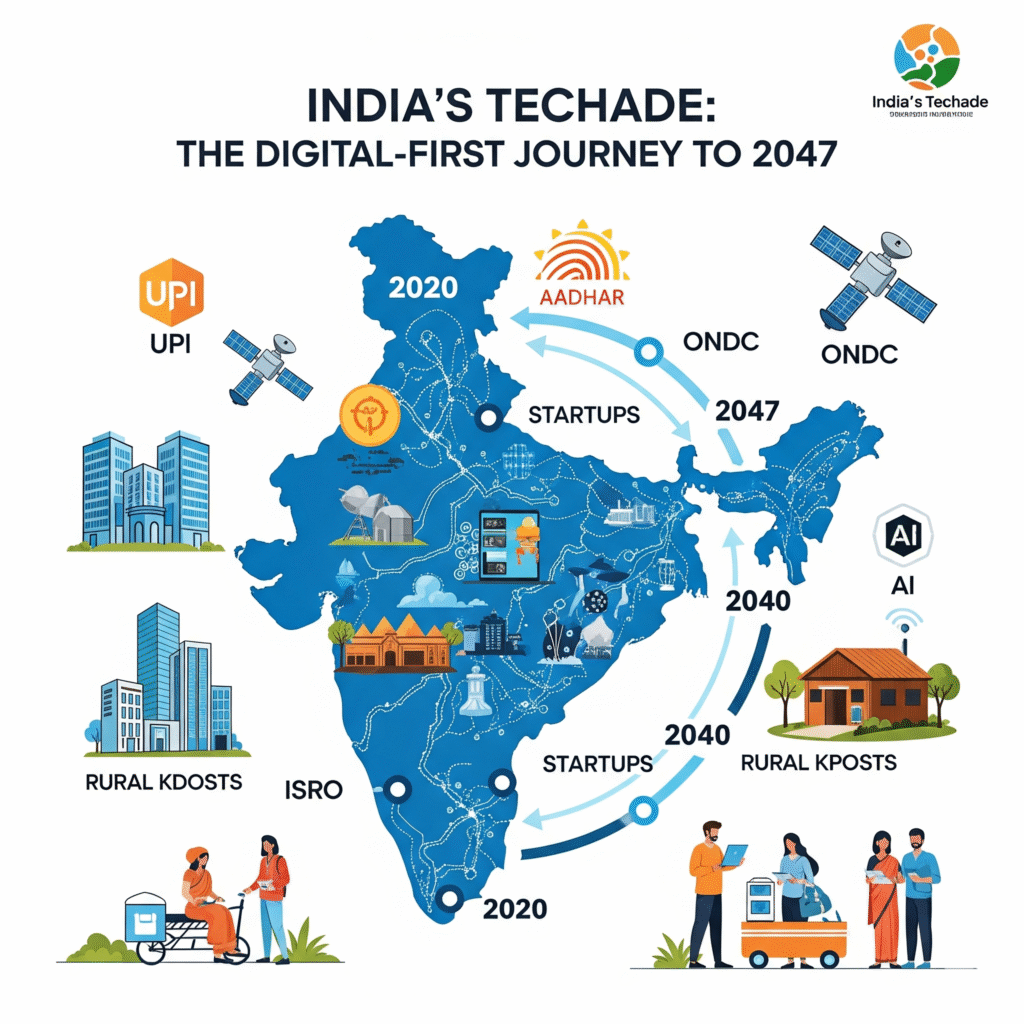
🌐 Introduction: A Nation’s Tech-Powered Ambition
From Davos to Silicon Valley, the term India’s Techade is gaining global traction. Coined to mark a decade of transformative digital growth, it reflects India’s ambition to become a developed nation by 2047, coinciding with the centenary of independence. But this is more than a catchphrase—it is a deeply strategic shift that blends digital infrastructure, entrepreneurial innovation, and grassroots inclusion into a unified national roadmap.
At the core lies the India Stack—a collection of interoperable, open-source protocols that facilitate identity, payments, and data management for all citizens. Built on these rails, India has pioneered UPI (Unified Payments Interface), now processing over 50% of the world’s real-time payment transactions by volume (Aci Worldwide Report, 2023).
🛠️ Pillar 1: Building a World-Class Digital Public Infrastructure (DPI)
India’s most significant digital leap has been the creation of Digital Public Infrastructure (DPI)—a framework that is open, inclusive, and radically scalable. Unlike Western models dominated by private monopolies, India’s DPI is citizen-first and government-backed, creating a more level playing field.
- 📇 Identity Layer – Aadhaar: Over 1.4 billion digital identities issued under Aadhaar now form the bedrock of service delivery, subsidy transfers, and KYC for banking.
- 💸 Payments Layer – UPI: As of May 2025, UPI handled 18.67 billion transactions worth ₹25.14 trillion in a single month, connecting 350 million individuals and 50 million merchants (NPCI).
- 🔐 Data Layer – DEPA: The Data Empowerment and Protection Architecture enables citizens to share financial and health data securely via account aggregators, fostering inclusive fintech innovation.
🛍️ Pillar 2: Democratizing Commerce and Entrepreneurship
India’s Techade doesn’t just digitize—it democratizes. With DPI as a springboard, small businesses, artisans, and startups are gaining access to national markets and digital capital.
- ONDC (Open Network for Digital Commerce): A landmark initiative aimed at breaking the duopoly of e-commerce giants. As of January 2025, ONDC has onboarded over 700,000 sellers and service providers across 616 cities, bringing Kirana stores, street vendors, and homepreneurs online.
- Tier-2 and Tier-3 Startups: DPI has unlocked entrepreneurship beyond metros. Startups in smaller towns are building scalable solutions for agriculture, logistics, ed-tech, and health, often with support from government programs like Startup India and Digital India.
- Credit & Inclusion: Leveraging digital trails, fintechs are offering micro-loans and insurance to the unbanked—many of whom are first-time users of formal financial systems.
🛰️ Pillar 3: Self-Reliance and Frugal Innovation
India’s digital push is underpinned by an ideology of Aatmanirbharta—or self-reliance. It champions indigenous innovation, not just to cut costs, but to solve India-specific problems with ingenuity and scale.
Nowhere is this more evident than in India’s space program. The Chandrayaan-3 mission, which successfully landed on the Moon’s south pole in August 2023, made India the first country to achieve this milestone. Earlier, the Mangalyaan mission reached Mars on a shoestring budget, showcasing India’s ability to do more with less.
That spirit of frugal innovation now drives advancements in defense tech, AI, green energy, and semiconductor design—areas critical for strategic autonomy. Government initiatives like Make in India and the Semiconductor Mission are enabling this shift by incentivizing domestic manufacturing and R&D.
🌍 Conclusion: A Blueprint for the World
India’s Techade is a transformational journey—not just toward digitization but toward inclusive, resilient, and self-sustaining growth. It’s a model where public infrastructure supports private innovation, where the digital divide narrows, and where development reaches every village and vendor—not just boardrooms.
In an era when many countries are debating the ethics of Big Tech monopolies, India is quietly building an alternative—one stack at a time. The rest of the world is watching closely, and many are already adapting the India Stack model for their own economies (World Bank, 2023).
As India approaches its 100th year of independence, its Techade vision could be the bridge between emerging aspirations and developed outcomes—for itself, and perhaps for the Global South at large.
📚 References
- UPI & real-time payments – NPCI Dashboard: 18.67B txns; ₹25.14T in May 2025 :contentReference[oaicite:7]{index=7}.
- Aadhaar stats – Over 1.38B IDs issued by UIDAI by July 2024 :contentReference[oaicite:8]{index=8}.
- ONDC onboarding – 700K+ sellers, 616 cities as of Jan 2025 :contentReference[oaicite:9]{index=9}.
- ISRO frugal space missions – Mangalyaan and Chandrayaan-3 costs ~$74–75M :contentReference[oaicite:10]{index=10}.